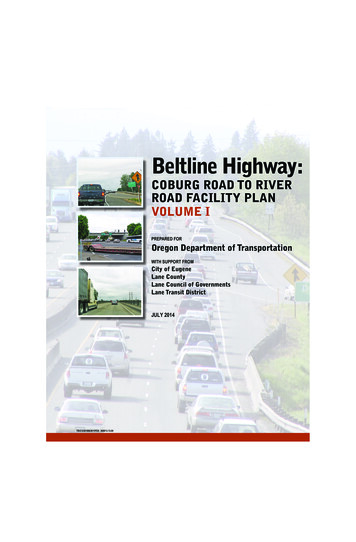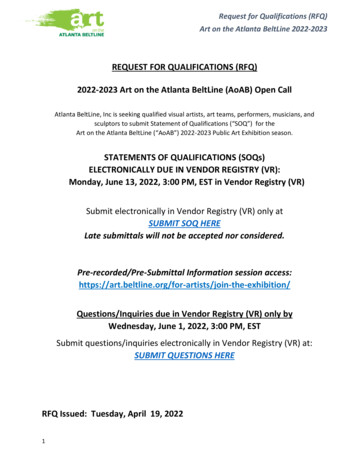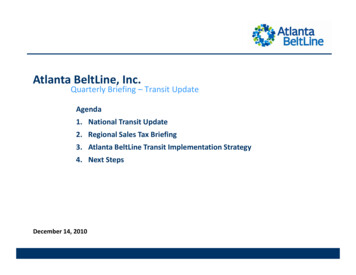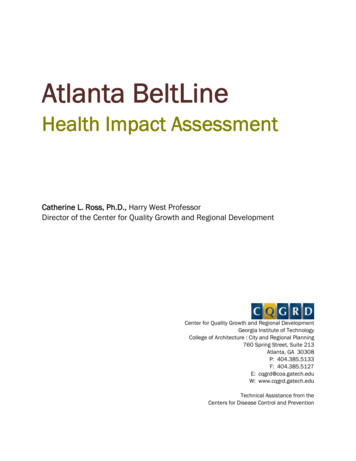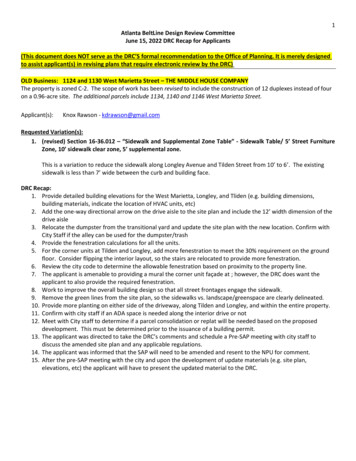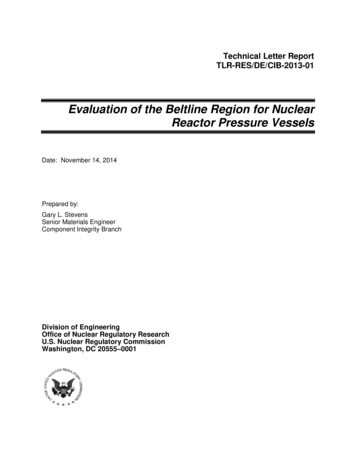
Transcription
Technical Letter ReportTLR-RES/DE/CIB-2013-01Evaluation of the Beltline Region for NuclearReactor Pressure VesselsDate: November 14, 2014Prepared by:Gary L. StevensSenior Materials EngineerComponent Integrity BranchDivision of EngineeringOffice of Nuclear Regulatory ResearchU.S. Nuclear Regulatory CommissionWashington, DC 20555–0001
TLR-RES/DE/CIB-2013-01ABSTRACTThis Technical Letter Report (TLR) is one in a series of reports developed by the NuclearRegulatory Commission’s (NRC’s) Component Integrity Branch (CIB) in the Division ofEngineering (DE) of the Office of Nuclear Regulatory Research (RES). The series of reportsdocument research efforts associated with reactor pressure vessel (RPV) materials and integrityissues performed by CIB since 2007. The intent of these reports is to document the results ofCIB’s research efforts for knowledge management purposes, as well as to provide a technicalreference for potential future regulatory needs. The current list of topics to be covered by thisset of RPV reports is as follows:A. Methods to Account for the Effect of Embrittlement on the Value of Adjusted ReferenceTemperatureB. Description of the PFM model used to assess cooldown, heatup, and leak testsC. Postulated flaw populations used to assess cooldown, heatup, and leak testsD. Evaluation of the Beltline Region for Nuclear Reactor Pressure VesselsE. PFM Analyses of Cooldown Transients for Normal OperationF. PFM Analyses of Heatup Transients for Normal OperationG. PFM Analyses of Leak Test Transients for Normal OperationH. Risk informed limits for normal operationI. Limits for Charpy V-notch energy on the upper shelfJ. Analysis of and toughness requirements for the flange region of the RPVK. Analysis of and toughness requirements for the nozzle region of the RPVL. The Effect of Shallow Internal Surface-Breaking Flaws on the Probability of BrittleFracture of Reactor Vessels Subjected to Normal Cool-Down TransientsM. Tabulation of the results of PFM analyses for normal operationThis report describes the evaluations performed to evaluate the beltline region of the RPV(Item D of the above list).Evaluation of the Beltline Region for Nuclear Reactor Pressure Vessels Page 2
TLR-RES/DE/CIB-2013-01CONTENTSABSTRACT . 2CONTENTS . 3LIST OF TABLES. 3LIST OF FIGURES . 3ABBREVIATIONS . 4SYMBOLS . 41.0OBJECTIVE . 52.0BACKGROUND . 63.0EVALUATIONS PERFORMED . 83.1Axial Neutron Fluence Profile Study . 83.2Adjusted Reference Temperature Study .123.3Power Reactor Surveillance Data Study .184.0SUMMARY OF RESULTS .195.0REFERENCES .20APPENDIX A: Definition of Neutron Fluence .22A.1References .22APPENDIX B: A Historical Perspective for Defining Beltline.24B.1References .28LIST OF TABLESTable 1.ART Sensitivity Study Results for the RG 1.99 Revision 2 ETC .13Table 2.ART Sensitivity Study Results for the 10 CFR 50.61a ETC .14Table A-1. Neutron Energy Range Names . A-1LIST OF FIGURESFigure 1.Figure 2.Figure 3.Figure 4.Figure 5.BWR Axial Neutron Fluence Profiles [12] .10PWR Axial Neutron Fluence Profiles [13] .11Plot of ART Sensitivity Study Results for the RG 1.99, Revision 2 ETC .15Plot of ART Sensitivity Study Results for the 10 CFR 50.61a ETC .16Comparison of 10 CFR 50.61a ETC T30 Estimates Made Using RVID2 vs.NRC-Approved License Renewal Materials Data .17Figure 6.Measured T30 vs. Neutron Fluence from Power Reactor Surveillance Data .18Figure B-1. Historical Variation in T30 Associated with Definition of Beltline .27Evaluation of the Beltline Region for Nuclear Reactor Pressure Vessels Page 3
FTLRDefinitionAdvisory Committee on Reactor SafeguardsAdjusted Reference TemperatureAmerican Society of Mechanical EngineersAmerican Society for Testing and MaterialsBottom of Active FuelBoiling Water ReactorCode of Federal RegulationsComponent Integrity BranchCopper ContentDivision of EngineeringEffective Full Power YearExtended Power UprateEnd-of-LicenseEmbrittlement Trend CurveFoot-PoundsLicense Renewal ApplicationLight Water ReactorMillion Electron VoltsNeutron Volt Thermal EnergyNuclear Regulatory CommissionOffice of Nuclear Reactor RegulationOffice of New ReactorsNuclear Steam Supply SystemPressure-TemperaturePressurized Thermal ShockPressurized Water ReactorReactor Coolant Pressure BoundaryOffice of Nuclear Regulatory ResearchRegulatory GuideReactor Pressure VesselReactor Vessel Integrity Database Version 2.0.1Top of Active FuelTechnical Letter ReportSYMBOLSSymbolRTNDTΔT30, RTNDTDefinitionReference temperature of nil ductility transition for the unirradiated material ( F)Mean value of the shift in reference temperature at a Charpy V-notch impact energy of30 ft-lbs (41J) caused by neutron radiation embrittlement ( F)Evaluation of the Beltline Region for Nuclear Reactor Pressure Vessels Page 4
TLR-RES/DE/CIB-2013-011.0OBJECTIVEThis report provides an evaluation of the beltline region of the reactor pressure vessel (RPV).Historically, the “beltline” region of the RPV has been described in both Nuclear RegulatoryCommission (NRC) regulations and industry standards (to be fully discussed in Section 2.0) asthe region adjacent to the reactor core that must be evaluated to account for the effects ofradiation on fracture toughness. For RPV materials, radiation is measured by neutron fluence†.As the U.S. fleet of operating reactors ages and continues in service, the beltine region of theRPV becomes larger in extent for several reasons. These reasons include longer operatingtime periods and reactor core changes (i.e., high burn-up fuel, extended power uprate (EPU)operation, longer fuel bundles, etc.), which lead to greater neutron fluence accumulation (in bothamount and area) throughout the RPV beltline and adjacent regions.The NRC has used a neutron fluence value of 1x1017 neutrons/centimer2 (n/cm2) with damagespectrum energies greater than one million electron volts (E 1 MeV) at the end-of-license(EOL) to define the extent of the RPV beltline. This definition is described in Section 2.2,Reactor Vessel Design, of NUREG-1511 [1], which ties the definition directly to Title 10, Part 50to the Code of Federal Regulations (10 CFR 50), Appendix (App.) G, “Fracture ToughnessRequirements” [2] and App. H, “Reactor Vessel Material Surveillance Program Requirements”[3]:The beltline of the reactor vessel is defined in Appendix G, 10 CFR Part 50, as theregion of the reactor vessel that directly surrounds the effective height of the active coreand the adjacent regions of the reactor vessel that are predicted to experience sufficientneutron damage to be considered in the selection of the limiting material with regard toradiation damage. The NRC staff considered materials with a projected neutron fluenceof greater than 1.0E17 neutrons per square centimeter (n/cm2) at end of license (EOL) toexperience sufficient neutron damage to be included in the beltline. This neutron fluenceis based on the surveillance requirements in Appendix H, 10 CFR Part 50.In this report, evaluations are documented that re-evaluate the definition of beltline stated inNUREG-1511 based on up to-date operating experience and RPV material surveillance data.†An introductory definition of neutron fluence is provided in Appendix A.Evaluation of the Beltline Region for Nuclear Reactor Pressure Vessels Page 5
TLR-RES/DE/CIB-2013-012.0BACKGROUNDThe commercial U.S. light water reactor (LWR) nuclear power industry has identified the need toassess different regions of nuclear RPVs for several reasons. In particular, the RPV beltlineregion is of interest because of the detrimental effect of neutron exposure on material propertiesin that region. Therefore, identifying a beltline region of the RPV is a means by which the needto estimate neutron fluence can be limited to just those portions of the RPV where radiationeffects are significant, thereby avoiding unnecessary, difficult, or costly evaluations. Suchreasoning assumes that there is a region of the RPV exposed to neutron fluence levels belowwhich radiation effects become insignificant. As a consequence, traditionally, the term beltlinehas been used to define the region immediately adjacent to the active core where significantradiation occurs. The background for the current definition of beltline used in industrystandards and regulatory documents is provided in Appendix B. That background issummarized in the remainder of this section based on passages from documents that,collectively, provide the definition of the RPV beltline region to support the context of theevaluations performed in this report.The definition of beltline from Section 4.3 of ASTM International, formerly known as theAmerican Society for Testing and Materials, E 185-82 (ASTM E185-82) [4], which is the versionof this standard currently referenced in 10 CFR 50 App. H [3], is as follows:“ the irradiated region of the reactor vessel (shell material including weld regions andplates or forgings) that directly surrounds the effective height of the active core, andadjacent regions that are predicted to experience sufficient neutron damage to warrantconsideration in the selection of surveillance material.”The definition of beltline from Section 3.1.2 of the most recent version of ASTM E 185-10 [5], isas follows:“.the irradiated region of the reactor vessel (shell material including weld seams andplates or forgings) that directly surrounds the effective height of the active core. Notethat materials in regions adjacent to the beltline may sustain sufficient neutron damageto warrant consideration in the selection of surveillance materials.”In the above quote, regions adjacent to the beltline that may sustain sufficient neutron damageare not considered as part of the beltline. They are only used for consideration in the selectionof surveillance materials. This is different from the beltline region defined in10 CFR 50 App. G [2] or 10 CFR 50.61, “Fracture Toughness Requirements for Protectionagainst Pressurized Thermal Shock Events” [6]:“Reactor Vessel Beltline means the region of the reactor vessel (shell material includingwelds, heat affected zones, and plates or forgings) that directly surrounds the effectiveheight of the active core and adjacent regions of the reactor vessel that are predicted toexperience sufficient neutron radiation damage to be considered in the selection of themost limiting material with regard to radiation damage.”NRC’s definition of the beltline region clearly includes adjacent regions of the reactor vessel thatare predicted to experience sufficient neutron radiation damage. Both NRC’s and ASTM’sdefinitions include terms such as “effective height,” “adjacent,” and “sufficient neutron damage”to specifically capture beltline effects that extend beyond the active height of the core. Asidentified in Section 1.0, NUREG-1511 identified a neutron fluence value that defines sufficientEvaluation of the Beltline Region for Nuclear Reactor Pressure Vessels Page 6
TLR-RES/DE/CIB-2013-01neutron radiation damage to avoid inconsistencies in the development and evaluation of RPVsurveillance programs in accordance with 10 CFR 50 App. H [3], pressurized thermal shock(PTS) evaluations in accordance with 10 CFR 50.61 [6], and RPV pressure-temperature (P-T)limits developed in accordance with 10 CFR 50 App. G [2] and the American Society ofMechanical Engineers (ASME) Boiler and Pressure Vessel Code (Code), Section XI,Nonmandatory Appendix G (ASME App. G) [7]. It is also consistent with the definitions includedin 10 CFR 50, App. H and ASTM E185-10.From Section III of 10 CFR 50 App. H [3], one criterion for surveillance programs is:“No material surveillance program is required for reactor vessels for which it can beconservatively demonstrated by analytical methods applied to experimental data andtests performed on comparable vessels, making appropriate allowances for alluncertainties in the measurements, that the peak neutron fluence at the end of thedesign life of the vessel will not exceed 1017 n/cm2 (E 1 MeV).”According to the 10 CFR 50 App. H [3] criterion, a surveillance program is required for reactorvessel with neutron fluence exceeding 1x1017 n/cm2 (E 1 MeV) at the end of the design life;the description in NUREG-1511 [1] reflects this concept that materials with neutron fluenceexceeding 1x1017 n/cm2 (E 1 MeV) at EOL are considered as beltline materials.The NRC’s neutron fluence value for the beltline region differed from a value of 1x1018 n/cm2(E 1.0 MeV) contained in Section 4 (Item B(5)) of Welding Research Council (WRC)Bulletin 175 [8], which is referenced as one of the technical basis documents in ASME App. G(endnote referenced in G-2120), as follows:"It is not feasible to name a specific fluence above which a surveillance program ismandatory. Available data show, however, that if the fluence at the inner wall is lessthan 1018 nvt ( 1 MeV) no significant radiation damage is to be expected. For highervalues of end-of-life fluence the omission of a surveillance program should be justified byshowing that for the particular lots of base and weld metal being used, the reactor vesselshell will not become more limiting than other parts of the vessel."NRC staff now recognize that, as RPVs are licensed to operate for longer time periods and corechanges are adopted (i.e., license renewal, high burn-up fuel, EPU operation, longer fuelbundles, etc.), the RPV region evaluated for significant irradiation effects may extend beyondthose regions traditionally evaluated as the beltline region. In addition, with the accumulation ofadditional operating experience gained from RPV materials surveillance programs, additionaldata are available to re-evaluate the level of neutron fluence where irradiation effects becomesignificant. Therefore, studies are summarized in this report that re-evaluate the neutronfluence level where irradiation effects are significant on the properties of RPV ferritic materials.Evaluation of the Beltline Region for Nuclear Reactor Pressure Vessels Page 7
TLR-RES/DE/CIB-2013-013.0EVALUATIONS PERFORMEDThe following evaluations were performed to review RPV regions and the neutron fluence levelwhere radiation effects are significant:1. Axial Neutron Fluence Profile Study: Axial neutron fluence profiles for sample plants(both Pressurized Water Reactors (PWRs) and Boiling Water Reactors (BWRs)) wereobtained to study neutron fluence variation above and below the top of active fuel (TAF)and bottom of active fuel (BAF) elevations in the RPV, respectively. The purpose of thisstudy was to identify neutron fluence levels for those RPV regions adjacent to the core.2. Adjusted Reference Temperature Study: Sensitivity studies were performed toinvestigate the effect of neutron fluence on adjusted reference temperature (ART)calculated by the embrittlement trend curves (ETCs) currently adopted in NRCregulations. Two ETCs are currently used by the NRC: (1) the ETC defined in SectionC of Regulatory Guide (RG) 1.99, Revision 2 [9], and (2) the ETC defined in Paragraph(g) of 10 CFR 50.61a, the Alternate Pressurized Thermal Shock (PTS) Rule [10]. Thepurpose of these studies was to identify neutron fluence levels above which these ETCspredict significant degradation of material fracture toughness caused by irradiation.3. Power Reactor Surveillance Data Study: A study of all available power reactorsurveillance data collected through approximately 2002 was performed to investigate theimpact of neutron fluence on the shift in measured reference temperature, i.e., RTNDT or T30. The purpose of this study was to review the data from the operating fleet ofreactors to see what level of neutron fluence caused a measurable impact on materialproperties caused by irradiation.Each of these studies is described in the following sections.3.1Axial Neutron Fluence Profile StudyIn the beginning of the commercial U.S. power industry, TAF and BAF elevations were used bysome of the nuclear steam supply system (NSSS) designers to define the RPV beltline regionbased on the active height of the nuclear core contained inside the RPV. This definition wasconsistent with Atomic Energy Commission (AEC) regulatory criteria. For example, the AEC’s1967 Supplementary Regulatory Criteria for ASME Code Constructed Nuclear PressureVessels, §1.38, “Attachments to Reactor Vessels” [11] stated the following:(a) For reactor vessels of ferritic materials, vessel nozzles shall not be located in any shellsections which directly surround the reactor core region and which is calculated toreceive integrated neutron doses in excess of 1x1017 nvt (E of 1 MeV and above).Therefore, it was common design practice for the NSSS designers to avoid placing stressdiscontinuities such as nozzles within the active core height region. This design practice alsoprevented creation of overly-restrictive RPV P-T operating limits caused by the high stressconcentration factor and significant radiation effects associated with stress discontinuities withinthe active core height region.Neutron fluence profiles that show neutron fluence as a function of RPV elevation are providedin Figure 1 and Figure 2 for sample BWR and PWR plants, respectively, for 32, 50, or 54effective full power years (EFPY) of operation [12, 13]. These profiles are from relatively recentEvaluation of the Beltline Region for Nuclear Reactor Pressure Vessels Page 8
TLR-RES/DE/CIB-2013-01evaluations that use the NRC-approved methods of RG 1.190 [14]. The location of the activecore is identified in each figure as the region between the BAF and TAF lines. The objective ofthis study is to find out how the neutron fluence attenuates above and below the active coreregion. From these figures, the following observations are made:a. Based on review of available neutron fluence reports and discussions with industrypersonnel, there are no known undue burdens or limitations on licensees for performingneutron fluence calculations to any reasonable neutron fluence level. Most neutronfluence vendors that were consulted are able to calculate neutron fluence in all regionsadjacent to the RPV active core for neutron fluence values as low as1x1016 n/cm2(E 1.0 MeV) at EOL. In one of the evaluations associated with Figure 1, neutronfluence was calculated as low as 1x1015 n/cm2 (E 1.0 MeV) at EOL.b. The difference in required RPV surface area needed for typical and low level of neutronfluence measurements is small. For example, comparing a neutron fluence value of1x1016 n/cm2 (E 1.0 MeV) at EOL to a value of 1x1017 n/cm2 (E 1.0 MeV) at EOL,Figure 1 and Figure 2 both indicate that an additional vertical height of approximately 40”would be required for evaluation. This additional height is not significant compared tothe overall area being evaluated.As noted in Figure 2, the RPV inlet and outlet nozzles may be within the beltline regiondepending upon the projected EOL neutron fluence. Figure 2 indicates these nozzles mayexperience irradiation levels above 1x1017 n/cm2 (E 1.0 MeV) at EOL for some PWR designs.Similarly, instrument, inlet, and outlet nozzles for BWRs (or selected other nozzles for latervintage BWRs) may also be within a beltline region defined as having a neutron fluence thatexceeds 1x1017 n/cm2 (E 1.0 MeV) at EOL. Historically, nozzles were considered to beoutside of the beltline region by some licensees because they were located above the TAFelevation or below the BAF elevation. In such cases, any corresponding shift in ART and theassociated impact on P-T limit curves for nozzles may have been neglected. However, asidentified in 10 CFR 50 App. G, the development of P-T limits must consider all ferriticcomponents for the entire RPV, including nozzles, and the effects of neutron radiation must beconsidered for any materials that are significantly impacted by radiation.The results of the Axial Neutron Fluence Profile Study support the following observations:i.The beltline region may extend above the TAF and below the BAF elevations of the RPVdepending upon the projected neutron fluence value at EOL used to define the beltlineregion. (This neutron fluence value is investigated in the other two studies documentedin this report.)ii.Neutron fluence evaluation beyond the elevations of the TAF and BAF to any reasonableneutron fluence level can be accomplished without undue burden to licensees.iii.Nozzles close to the reactor core elevation may reside within the beltline region,therefore requiring the impact of irradiation to be evaluated.Evaluation of the Beltline Region for Nuclear Reactor Pressure Vessels Page 9
TLR-RES/DE/CIB-2013-01Figure 1. BWR Axial Neutron Fluence Profiles [12]Evaluation of the Beltline Region for Nuclear Reactor Pressure Vessels Page 10
TLR-RES/DE/CIB-2013-01Figure 2. PWR Axial Neutron Fluence Profiles [13]Evaluation of the Beltline Region for Nuclear Reactor Pressure Vessels Page 11
TLR-RES/DE/CIB-2013-013.2Adjusted Reference Temperature StudyFor deterministic assessments, adjusted reference temperature (ART) is defined as the initialunirradiated RTNDT plus the shift in the mean reference temperature caused by irradiation plusany applicable margin. ART calculations were performed in this study using the ETCs definedin RG 1.99, Revision 2 [9] and 10 CFR 50.61a [10] to determine whether it is necessary toinclude embrittlement evaluation for RPV materials having neutron fluence values less than1x1017 n/cm2 (E 1 MeV) at EOL. RG1.99, Revision 2 and 10 CFR 50.61a define the shift inmean reference temperature caused by irradiation as RTNDT and T30, respectively. Thepurpose of using both ETCs is to assess the sensitivity of the results due to different ETCs.Both ETCs estimate ART as a function of variables that define the irradiation environment andthe chemical composition of the steel.Information from the NRC’s Reactor Vessel Integrity Database Version 2.0.1 (RVID2) [15] wasused for the ART calculations. The 40-year EOL (32 EFPY) neutron fluence values in RVID2were increased by 54/32 to estimate 60-year (54 EFPY) EOL values; therefore, the results ofthese sensitivity studies reflect the estimated impact of 60 years of plant operation. The resultsare shown in Table 1 and Figure 3 for the RG 1.99, Revision 2 ETC, and in Table 2 andFigure 4 for the 10 CFR 50.61a ETC. The 381 data points for BWRs and 602 data points forPWRs shown in Table 1 and Table 2 consist of plates, forgings, and welds.The data in RVID2 summarizes 40-year operating period data for U.S. licensees and, as aresult, has not been updated since the 2000 timeframe. Therefore, RES performed anassessment of updates made by licensees to their plant-specific materials data as a part ofrecent license renewal application (LRA) submittals. The purpose of this assessment was tocheck the adequacy of the RVID2 data used in the ART Sensitivity Study. This assessmentincluded a sampling of 84 limiting materials reported in NRC-approved LRAs submitted since1998. For these materials, T30 calculations were performed using the 10 CFR 50.61a ETC andthe material data from the LRAs. The resulting T30 values were compared to T30 valuesresulting from calculations using the 10 CFR 50.61a ETC and the material data from RVID2 forthe same 84 materials. The results of this comparison and the related statistics are shown inFigure 5. The diagonal line in the figure represents equal T30 values using the two differentdata sources.The results of the ART Sensitivity Study support the following observations:i.ii.iii.For the RG 1.99, Revision 2 ETC:a. The average RTNDT remains below 10 F for neutron fluence values less than1x1017 n/cm2 (E 1.0 MeV) at EOL.b. The maximum RTNDT remains below 23 F for neutron fluence values lessthan1x1017 n/cm2 (E 1.0 MeV) at EOL.For the 10 CFR 50.61a ETC:a. For PWRs, the average T30 is less than 10 F, and the maximum T30 is lessthan 25 F, for a neutron fluence value equal to 5x1016 n/cm2 (E 1.0 MeV) atEOL.b. For BWRs, the average T30 is less than 15 F, and the maximum T30 is 30 F,for a neutron fluence value equal to 5x1016 n/cm2 (E 1.0 MeV) at EOL.These results of T30 predictions made using RVID2 do not differ significantly from thosemade using information from LRAs. Therefore, the use of RVID2 for the ART SensitivityStudy, with the results plotted in Figure 3 and Figure 4, is concluded to provide anadequate assessment for the current U.S. operating fleet.Evaluation of the Beltline Region for Nuclear Reactor Pressure Vessels Page 12
TLR-RES/DE/CIB-2013-01Based on the above observations, it can be concluded that it is unnecessary to includeembrittlement evaluation for RPV materials having neutron fluence values less than1x1017 n/cm2 (E 1.0 MeV) at EOL.Table 1. ART Sensitivity Study Results for the RG 1.99 Revision 2 ETC#Plant Type PointsAverageNeutron Fluence: 1.000E 16 n/cm 2 (E 1.0 MeV)Initial RTNDT ( F) RTNDT ( F)MaximumMinimumStd. Dev.AverageMaximumMinimumART ( F)Std. Dev.AverageMaximumMinimumStd. 4-79.435.2Std. Dev.Average#Plant Type PointsAverageNeutron Fluence: 2.000E 16 n/cm 2 (E 1.0 MeV)Initial RTNDT ( F) RTNDT ( F)MaximumMinimumStd. Dev.AverageMaximumMinimumART ( F)MaximumMinimumStd. -78.935.1Std. Dev.Average#Plant Type PointsAverageNeutron Fluence: 5.000E 16 n/cm 2 (E 1.0 MeV)Initial RTNDT ( F) RTNDT ( F)MaximumMinimumStd. Dev.AverageMaximumMinimumART ( F)MaximumMinimumStd. .5-77.734.9Std. Dev.Average#Plant Type PointsAverageNeutron Fluence: 7.000E 16 n/cm 2 (E 1.0 MeV)Initial RTNDT ( F) RTNDT ( F)MaximumMinimumStd. Dev.AverageMaximumMinimumART ( F)MaximumMinimumStd. 1-76.934.9Std. Dev.Average#Plant Type PointsAverageNeutron Fluence: 1.000E 17 n/cm 2 (E 1.0 MeV)Initial RTNDT ( F) RTNDT ( F)MaximumMinimumStd. Dev.AverageMaximumMinimumART ( F)MaximumMinimumStd. 2-76.035.0Std. Dev.Average#Plant Type PointsAverageNeutron Fluence: 5.000E 17 n/cm 2 (E 1.0 MeV)Initial RTNDT ( F) RTNDT ( F)MaximumMinimumStd. Dev.AverageMaximumMinimumART ( F)MaximumMinimumStd. 9.7142.8-68.340.3Std. Dev.Average#Plant Type PointsAverageNeutron Fluence: 1.000E 18 n/cm 2 (E 1.0 MeV)Initial RTNDT ( F) RTNDT ( F)MaximumMinimumStd. Dev.AverageMaximumMinimumART ( F)MaximumMinimumStd. 6.2159.2-62.645.7Evaluation of the Beltline Region for Nuclear Reactor Pressure Vessels Page 13
TLR-RES/DE/CIB-2013-01Table 2. ART Sensitivity Study Results for the 10 CFR 50.61a ETC#Plant Type PointsAverageNeutron Fluence: 1.000E 16 n/cm 2 (E 1.0 MeV)Initial RTNDT ( F) T30 ( F)MaximumMinimumStd. Dev.AverageMaximumMinimumART ( F)Std. Dev.AverageMaximumMinimumStd. -75.935.2Std. Dev.Average#Plant Type PointsAverageNeutron Fluence: 2.000E 16 n/cm 2 (E 1.0 MeV)Initial RTNDT ( F) T30 ( F)MaximumMinimumStd. Dev.AverageMaximumMinimumART ( F)MaximumMinimumStd. 3-74.735.1Std. Dev.Aver
collectively, provide the definition of the RPV beltline region to support the context of the evaluations performed in this report. The definition of beltline from Section 4.3 of ASTM International, formerly known as the American Society for Testing and Materials, E 185-82 (ASTM E185-82) [4], which is the version


